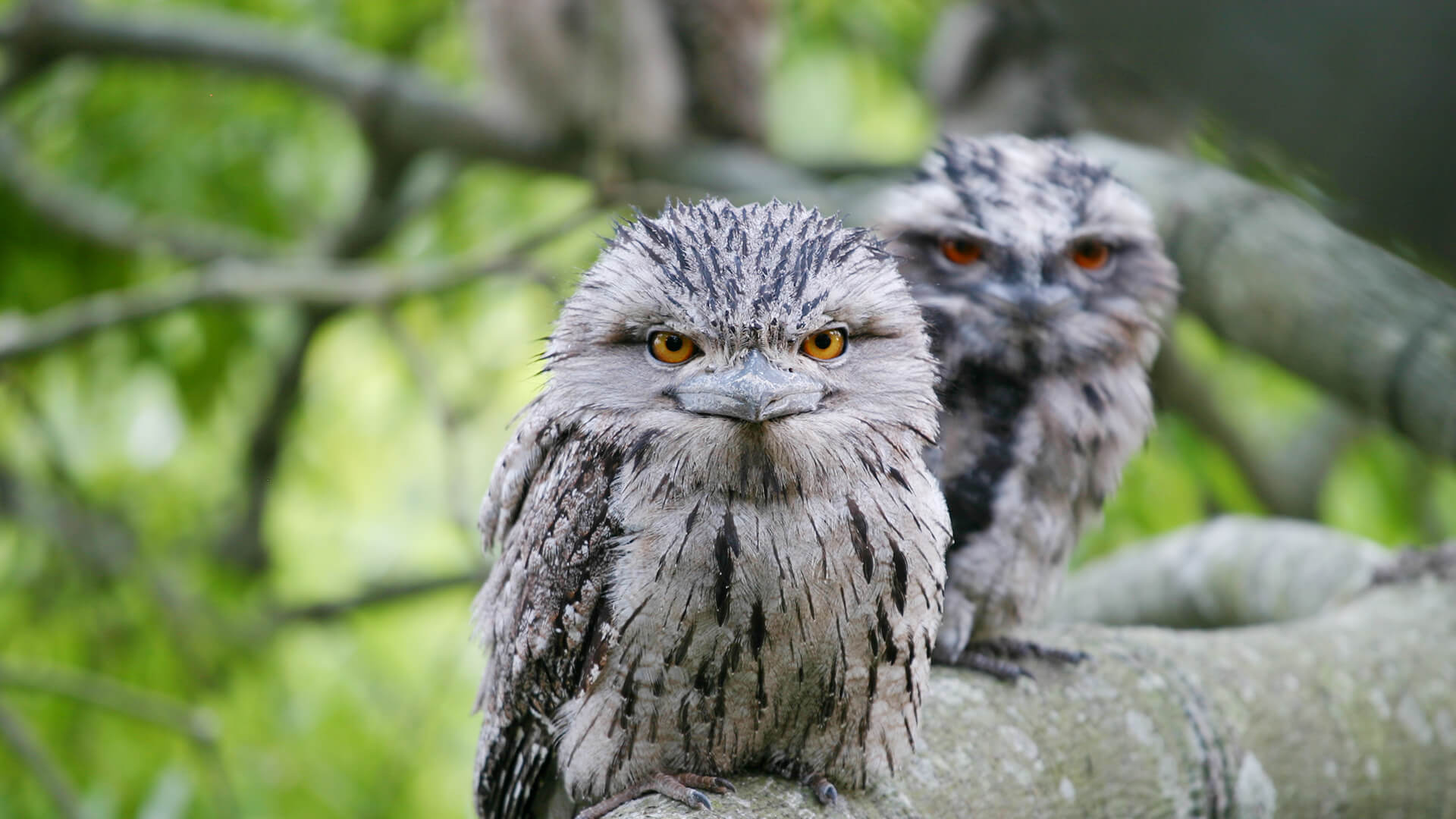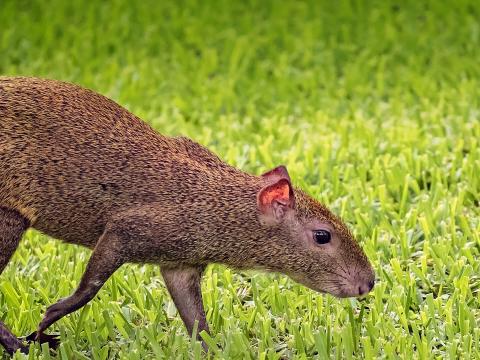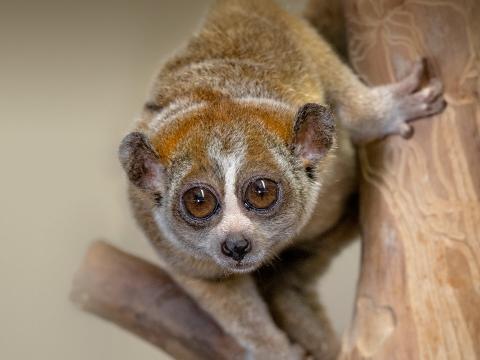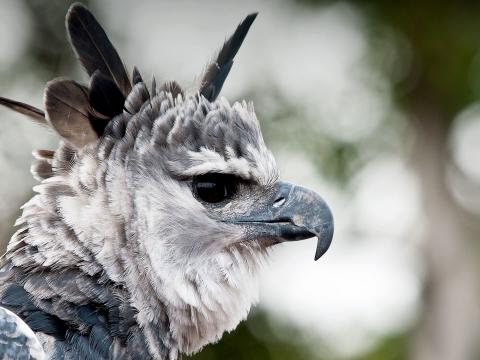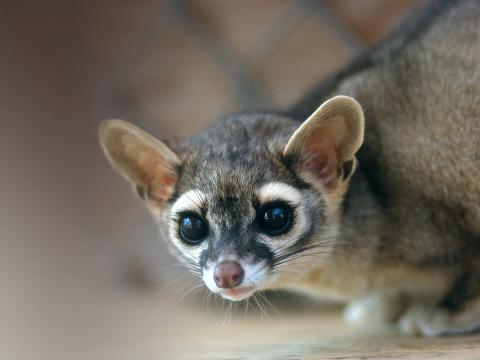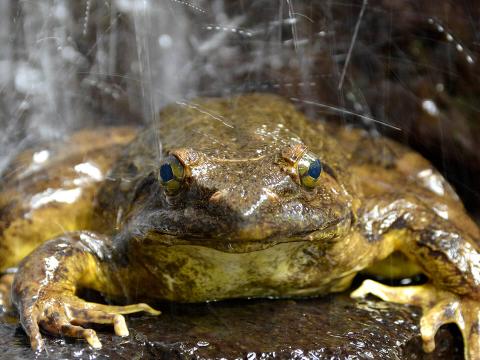Tawny Frogmouth
- CLASS: Aves (Birds)
- ORDER: Caprimylgiformes
- FAMILY: Podargidae
- GENUS: Podargus
- SPECIES: strigoides
ABOUT
Can you see me now? While often confused for an owl (or mistaken for a frog by name), the tawny frogmouth is actually part of the nightjar family. These medium-sized nocturnal or crepuscular birds are noted for their long wings, short legs, and stout bills. The tawny frogmouth is active at night; by day it perches in trees perfectly camouflaged. They are native to Australia and also found on Tasmania. Tawny frogmouths have rather weak legs and feet to grab prey; instead, they pounce and use their wide, hooked beak to dispatch they prey. Their primary feathers are frayed like those of owls for silent flight, but they use the sit-and-wait strategy until potential prey wanders into ambush range.
There are about 14 frogmouths species, most with large, bright yellow eyes and a wide set beak that is yellowish to olive gray in color. The beak is abnormally wide like the mouth of a frog, triangular in shape, and sharply hooked, with whisker-like bristles around the bill. These short and stout birds measure 8.5 to 21 inches tall and weigh up to 1.5 pounds. Their plumage is a brownish gray with mottled black streaks and spots, providing them the ideal camouflage against tree bark. They have wispy feathers on their heads and very thin, bristly feathers around their beak. They have short legs and weak feet (unlike owls). Their wings are rounded and medium length with frayed edges that allow for silent flight (or rapid decent to the ground to capture prey) at night, similar to that of an owl.
When threatened, tawny frogmouths rely on camouflage to stay safe; its mottled plumage enables it to blend seamlessly into their forest environment. They remain perfectly still, with eyes closed, and beak pointed skyward. Only if approached too closely will their cover be blown as the frogmouths take flight or try to intimidate the predator by opening their cavernous, bright yellow mouth. Predators include foxes, and domestic dogs and cats.
Tawny frogmouths are not the most “talkative” of birds. The will hiss if they feel threatened and make a buzzing sound similar to a bee when startled. They can be confused with the boobooks’ call of “Whu-WOOK!” but the usual call of the frogmouth is “Ooom-ooom-ooom.”
HABITAT AND DIET
The tawny frogmouth is an adaptable bird inhabiting a variety of habitats throughout Australia and Tasmania. They dwell in forests, scrubland, eucalyptus and acacia woodlands, and suburban parks. The only places it avoids are treeless areas or dense rainforests. Because the tawny frogmouth is adaptable enough to live in suburban areas, this can put them at risk of getting hit by cars while chasing insects illuminated in the beam of vehicle headlights.
They live in pairs, maintaining a territory of less than a half of a mile. The pair roosts during the day near each other on branches or even shaded ground to remain inconspicuous. Tawny frogmouths are nocturnal. During the day, they are typically perched in a tree, low to the ground, blending in to the tree. At night, they hunt for food using the sit-and-wait technique, as opposed to other nighttime predators who actively go after their prey.
The tawny frogmouth’s diet consists largely of insects, making it classified as an insectivore. They also feast on spiders, worms, slugs, snails, centipedes, and even cockroaches. They opportunistically feed on small mammals, reptiles, frogs, and other types of birds. As sit-and-wait predators, they remain still, perched in a tree, then pounce on prey to capture it. They will catch some items like moths in flight, which is why oncoming traffic can be a threat to these birds. Here at the San Diego Zoo the tawny frogmouth diet consists of mice, pinkies, crickets, giant mealworms, and wax worms.
FAMILY LIFE
Tawny frogmouths form monogamous pairs for breeding. They stay together for life! Breeding season is August through December of each year; typically heavy seasonal rains spark the start of breeding time. They tend to use the same breeding site each year, maintaining their nest with available leaves, feathers, moss, or lichen. Both sexes incubate and defend the nest from predators. The eggs are incubated for about 30 days. After hatching, both parents feed the hungry chicks until 25-35 days of age, when the hatchlings finally leave the nest.
CONSERVATION
The tawny frogmouth is listed by the IUCN as a species of least concern. Their biggest threat is human related: they often run into cars as they chase after moths that are attracted to the light beams of vehicle headlights. They are also at risk of being poisoned by pesticides, as they can be found in urbanized areas. A termite pesticide was banned throughout Sydney, Australia, due to the toxicity to wildlife including the tawny frogmouth. Predators include foxes, and domestic dogs and cats.
By supporting San Diego Zoo Wildlife Alliance, you are our ally in saving and protecting wildlife worldwide.

